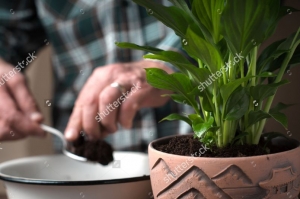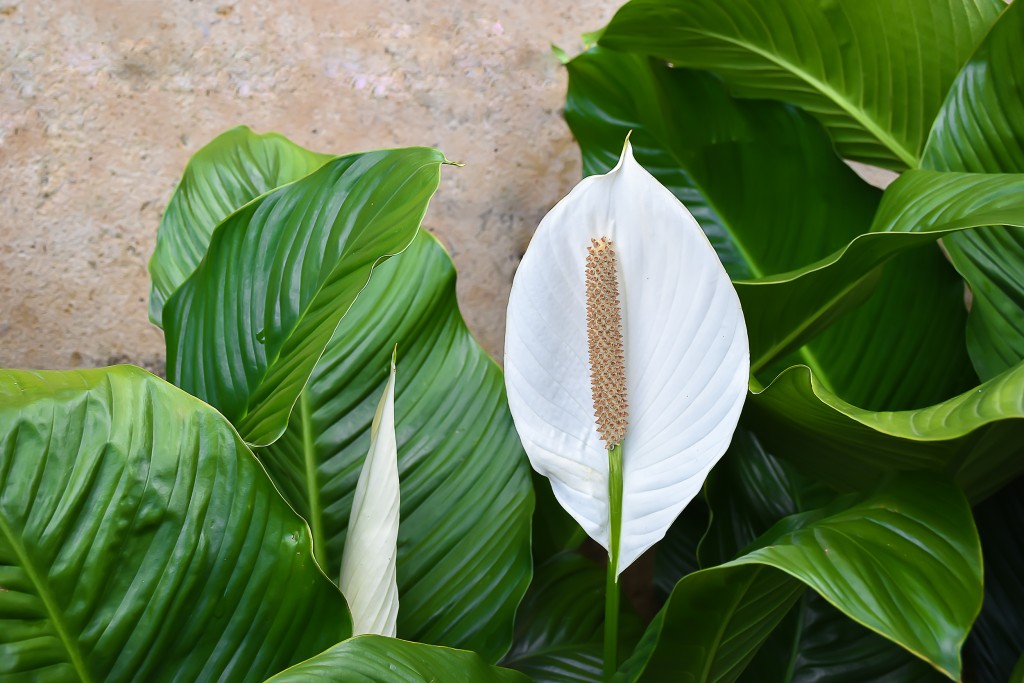The tranquil Peace Lily, Spathiphyllum, is a beautiful flowering plant with long broad glossy green leaves and white flowers that stretch up over the plant. There is a serenity that overtakes the room when one of these plants makes it into the space. Part of it is due to its ability to clean the surrounding air, literally giving the area a breath of fresh air. And the other is the beauty of the flowers sweeping grace that exhibits nature’s artistic tranquility.
Spathiphyllum is not a true “lily” and instead has a rhizomatous type root (think ginger or turmeric root) and comes from the forests of South America. It is more closely related to the Anthurium. It is a rugged plant and can tolerate a variety of light conditions, including semi-darkness.
As one of the plants on NASA’S Top Ten Household Air Cleaning Plants their study done in 1989 shows the peace lily absorbs such toxins as formaldehyde and carbon monoxide through its respiration process. Formaldehyde slowly outgasses from resins used in items such as furniture, cabinets and carpets. Carbon monoxide is produced from anything that is burned such as gas appliances, automobile exhaust, fireplaces, water heaters and furnaces.
Though proper appliance maintenance and avoidance of chemically made products is the best prevention for these types of toxic fumes, the peace lily is a great addition to the indoors for absorbing these wastes.
HOW TO CARE FOR A PEACE LILY
DON’T OVERWATER Taking care of these plants is simple. Peace lilies are drought tolerant and only need to be watered if their soil is dry. Check the plant once a week by touching the top soil and if dry, water the plant. Some people even wait until the plant begins to droop before watering so as not to over water.
FERTILIZING These wonderful plants only need fertilizing 1 or 2 times a year. Some people don’t even fertilize their plants at all. It is best to fertilize when the plant is actively growing or producing blooms. Use a balanced fertilizer, 20-20-20 and dilute to one-half or quarter strength. Do not over feed. This might create brown spots on the leaves. If the flowers are somewhat green around the edges instead of creamy white, it is probably due to over fertilizing. Be sure to water after feeding to evenly distribute the fertilizer. Never use fertilizer on dry roots.
BLOOMING Flowering appears only in a mature plant during spring and early summer. And when they bloom, they last for at least a month. Most commercial growers stimulate the flowers with a growth hormone (such as gibberellic acid) due to their immaturity. It can take up to a year for the plant to fully develop. If the plant is still not producing flowers, follow this checklist:
- Needs well-draining, rich organic soil
- Water 2 -3 times per week. Try distilled water to avoid chemicals and minerals in tap water.
- Feed balanced fertilizer every 2 to 3 months
- Keep in low-light condition out of direct sunlight, then move to brighter light to stimulate blooming.
 REPOTTING The lilies like to be root bound in their container but do well from repotting or dividing when they finally outgrow their home. Several signs that show a peace lily needs a new container is droopy leaves less then a week after watering; as well as crowded and deformed leaf growth. Use a pot that is at least 2″ larger than the current one.
REPOTTING The lilies like to be root bound in their container but do well from repotting or dividing when they finally outgrow their home. Several signs that show a peace lily needs a new container is droopy leaves less then a week after watering; as well as crowded and deformed leaf growth. Use a pot that is at least 2″ larger than the current one.
DIVIDING As the rootball grows larger it might be best to divide the plant. When repotting, the lilies can be dividing into two. Use a knife to slice down the center of the rootball and replant each in its own container.
DUST THE LEAVES The beautiful wide leaves of the peace lily picks up a lot of dust. Depending on the amount of dust that accumulates, wipe down the leaves with a clean damp cloth once a month or at least twice a year. Since plants process sunlight through their leaves, this helps them absorb the necessary light for photosynthesis. Using commercial leaf shine products can clog their pores. Also, giving it a shower is another option. For areas where the water is heavily chlorinated, fill a container and let it sit for an hour before watering so most of the chlorine dissipates into the air; or simply use distilled water.







